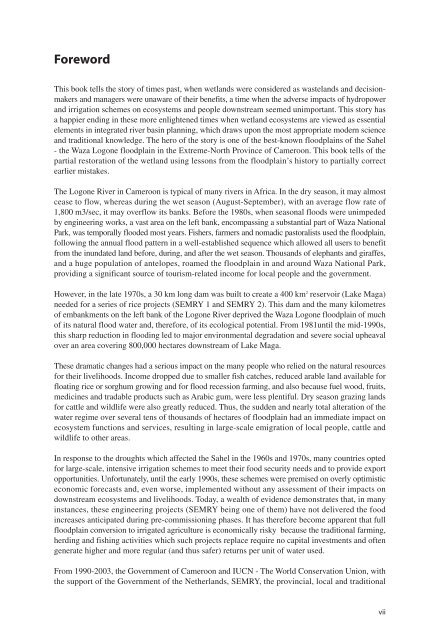The return of the water - IUCN
The return of the water - IUCN
The return of the water - IUCN
Create successful ePaper yourself
Turn your PDF publications into a flip-book with our unique Google optimized e-Paper software.
Foreword<br />
This book tells <strong>the</strong> story <strong>of</strong> times past, when wetlands were considered as wastelands and decisionmakers<br />
and managers were unaware <strong>of</strong> <strong>the</strong>ir benefits, a time when <strong>the</strong> adverse impacts <strong>of</strong> hydropower<br />
and irrigation schemes on ecosystems and people downstream seemed unimportant. This story has<br />
a happier ending in <strong>the</strong>se more enlightened times when wetland ecosystems are viewed as essential<br />
elements in integrated river basin planning, which draws upon <strong>the</strong> most appropriate modern science<br />
and traditional knowledge. <strong>The</strong> hero <strong>of</strong> <strong>the</strong> story is one <strong>of</strong> <strong>the</strong> best-known floodplains <strong>of</strong> <strong>the</strong> Sahel<br />
- <strong>the</strong> Waza Logone floodplain in <strong>the</strong> Extreme-North Province <strong>of</strong> Cameroon. This book tells <strong>of</strong> <strong>the</strong><br />
partial restoration <strong>of</strong> <strong>the</strong> wetland using lessons from <strong>the</strong> floodplain’s history to partially correct<br />
earlier mistakes.<br />
<strong>The</strong> Logone River in Cameroon is typical <strong>of</strong> many rivers in Africa. In <strong>the</strong> dry season, it may almost<br />
cease to flow, whereas during <strong>the</strong> wet season (August-September), with an average flow rate <strong>of</strong><br />
1,800 m3/sec, it may overflow its banks. Before <strong>the</strong> 1980s, when seasonal floods were unimpeded<br />
by engineering works, a vast area on <strong>the</strong> left bank, encompassing a substantial part <strong>of</strong> Waza National<br />
Park, was temporally flooded most years. Fishers, farmers and nomadic pastoralists used <strong>the</strong> floodplain,<br />
following <strong>the</strong> annual flood pattern in a well-established sequence which allowed all users to benefit<br />
from <strong>the</strong> inundated land before, during, and after <strong>the</strong> wet season. Thousands <strong>of</strong> elephants and giraffes,<br />
and a huge population <strong>of</strong> antelopes, roamed <strong>the</strong> floodplain in and around Waza National Park,<br />
providing a significant source <strong>of</strong> tourism-related income for local people and <strong>the</strong> government.<br />
However, in <strong>the</strong> late 1970s, a 30 km long dam was built to create a 400 km 2 reservoir (Lake Maga)<br />
needed for a series <strong>of</strong> rice projects (SEMRY 1 and SEMRY 2). This dam and <strong>the</strong> many kilometres<br />
<strong>of</strong> embankments on <strong>the</strong> left bank <strong>of</strong> <strong>the</strong> Logone River deprived <strong>the</strong> Waza Logone floodplain <strong>of</strong> much<br />
<strong>of</strong> its natural flood <strong>water</strong> and, <strong>the</strong>refore, <strong>of</strong> its ecological potential. From 1981until <strong>the</strong> mid-1990s,<br />
this sharp reduction in flooding led to major environmental degradation and severe social upheaval<br />
over an area covering 800,000 hectares downstream <strong>of</strong> Lake Maga.<br />
<strong>The</strong>se dramatic changes had a serious impact on <strong>the</strong> many people who relied on <strong>the</strong> natural resources<br />
for <strong>the</strong>ir livelihoods. Income dropped due to smaller fish catches, reduced arable land available for<br />
floating rice or sorghum growing and for flood recession farming, and also because fuel wood, fruits,<br />
medicines and tradable products such as Arabic gum, were less plentiful. Dry season grazing lands<br />
for cattle and wildlife were also greatly reduced. Thus, <strong>the</strong> sudden and nearly total alteration <strong>of</strong> <strong>the</strong><br />
<strong>water</strong> regime over several tens <strong>of</strong> thousands <strong>of</strong> hectares <strong>of</strong> floodplain had an immediate impact on<br />
ecosystem functions and services, resulting in large-scale emigration <strong>of</strong> local people, cattle and<br />
wildlife to o<strong>the</strong>r areas.<br />
In response to <strong>the</strong> droughts which affected <strong>the</strong> Sahel in <strong>the</strong> 1960s and 1970s, many countries opted<br />
for large-scale, intensive irrigation schemes to meet <strong>the</strong>ir food security needs and to provide export<br />
opportunities. Unfortunately, until <strong>the</strong> early 1990s, <strong>the</strong>se schemes were premised on overly optimistic<br />
economic forecasts and, even worse, implemented without any assessment <strong>of</strong> <strong>the</strong>ir impacts on<br />
downstream ecosystems and livelihoods. Today, a wealth <strong>of</strong> evidence demonstrates that, in many<br />
instances, <strong>the</strong>se engineering projects (SEMRY being one <strong>of</strong> <strong>the</strong>m) have not delivered <strong>the</strong> food<br />
increases anticipated during pre-commissioning phases. It has <strong>the</strong>refore become apparent that full<br />
floodplain conversion to irrigated agriculture is economically risky because <strong>the</strong> traditional farming,<br />
herding and fishing activities which such projects replace require no capital investments and <strong>of</strong>ten<br />
generate higher and more regular (and thus safer) <strong>return</strong>s per unit <strong>of</strong> <strong>water</strong> used.<br />
From 1990-2003, <strong>the</strong> Government <strong>of</strong> Cameroon and <strong>IUCN</strong> - <strong>The</strong> World Conservation Union, with<br />
<strong>the</strong> support <strong>of</strong> <strong>the</strong> Government <strong>of</strong> <strong>the</strong> Ne<strong>the</strong>rlands, SEMRY, <strong>the</strong> provincial, local and traditional<br />
vii












